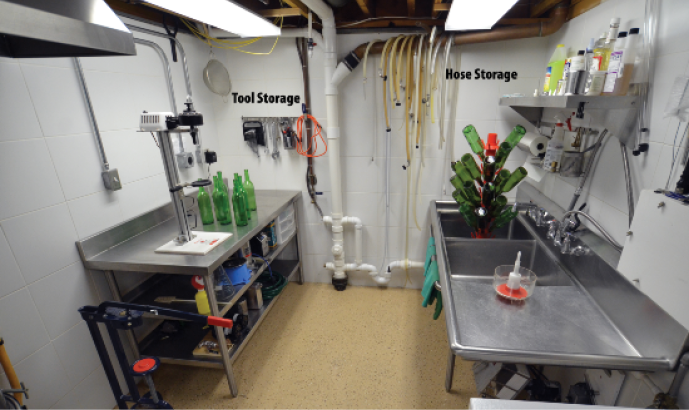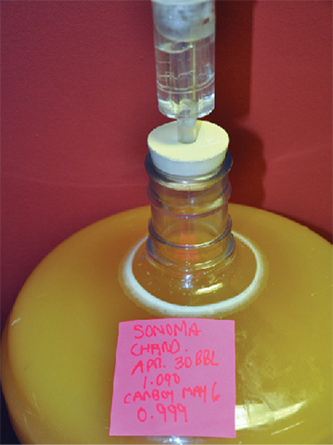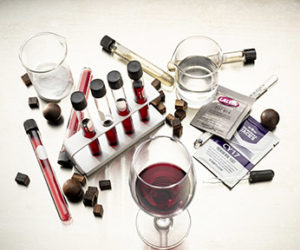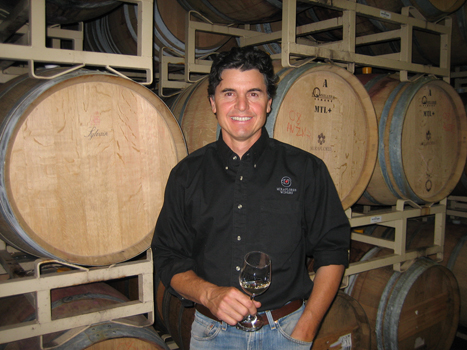
Not every day can be harvest day, but that doesn’t mean that your home winery couldn’t use some company year round. There are times that lend themselves to more quiet reflection in the winery rather than the excitement of crush and press, or active fermentations. It is during these periods that you have a chance to take a deep breath, assess the wines you have made over the course of the year, go over some notes, take an inventory, and decide if you will make any adjustments to your winemaking in the coming days. Here, with the advice of a handful of professional winemakers, are ten ways for you to get in touch with your winery, get ready for the next vintage, and make your winemaking more efficient and rewarding.
1. Clean and organize
With your wines safely in their tanks, barrels, or carboys, take the time to give your winery a good deep clean. Give all your equipment and surfaces a good scrub, sanitize everything, hang and store equipment properly, and get rid of anything you don’t need in your space. Pull shelving and tables out of their normal spots and clean behind and around anything that normally gets overlooked.
When you’re taking stock and looking forward to the year ahead, Robert Herold, winemaker at M&M Wine Grape Company, based in Hartford, Connecticut, advises thoroughly cleaning and sanitizing your equipment with emphasis on a critical basic rule: “Clearly understand the difference between cleaning and sanitizing; they are not the same!” he said, “And do not rinse after sanitizing.”
The experienced winemaker, who contributes to WineMaker magazine and serves on the National Board of Directors for the American Wine Society, says hoses should all be stored vertically until completely dry on the inside to preclude internal mold growth. John Blichmann, an avid home winemaker and president of Blichmann Engineering, based in Lafayette, Indiana, adds that mop or broom hangers are great for hanging hoses.
John also says that as you embark on a new year of winemaking, don’t be afraid to try new products. “Saniclean and StarSan are great no-rinse sanitizers and are faster and more thorough than traditional products like sulfites and citric acid,” he says. “Powdered Brewery Wash (PBW) does an amazing job cleaning wine stains off of equipment. And it is super to use in the dishwasher to clean wine glasses!” said Blichmann.
2. Take Inventory and Restock
Once your home winery is clean, sanitized, and organized, it will be easier to go through your winemaking supplies and take down an inventory of everything you have and everything you might need. As you clean and sanitize, check the dates on your products (yeast nutrient, enzymes, etc.), does anything need to be thrown away or replenished? Do you need more potassium metabisulfite? Now is the time to order more ingredients so that you can be ready for the next batch.
“Most additives and chemicals used in winemaking have finite shelf lives, some as short as six months,” says Herold. “Make sure you are using fresh, viable ingredients to insure the potency and results you expect,” he adds. Blichmann says he buys new sulfites every winemaking season and stores them in a thick plastic zippered storage bag inside a sealed Tupperware container.
Sheridan Warrick, author of The Way to Make Wine: How to Craft Superb Table Wines at Home (2d ed., University of California Press, 2015), says late winter into spring is when he thinks about his bottle inventory. “How many do I have on hand? How many will I need? I make a couple of reds every year and usually a white or a rosé, so I want different bottles — possibly both dark green Bordeaux- and Burgundy-style ones for the reds and clear Bordeaux-style for the whites and pinks,” said Warrick, who has made wine at his home in northern California for 35 years.
“I buy in bulk to keep the price down. That means checking with other winemakers I know to see if we can split a pallet, typically 56 cases. And I count my corks, too, of course. I like to bottle in July, to empty the carboys for the fall,” he adds.
3. Inspect tools and equipment

If you take good care of your winemaking equipment, and keep it clean and properly stored, most items can last for years. But some items don’t last forever. Inspect your tools, vessels, tubing/hose, and anything else that comes in contact with your wine. Is anything cracked or scratched? Does anything need to be fixed or replaced?
Herold doesn’t take any chances. “Replace batteries on electronic devices such as scales, pH and other meters. Old batteries always die when you need them the most,” he says. “Scratched plastic surfaces (such as in fermentation buckets) are great at harboring spoilage agents. If it’s scratched, replace it!”
Blichmann says if you use vinyl hoses plan on replacing them if they get discolored, or at least every other year in a typical home winemaking environment. For a longer lasting hose, he says silicone is an option. “It can be boiled and is impervious to about any chemical, but it is expensive and isn’t clear.”
4. Check your Cellar and Anything That is Bulk Aging
After you’ve got your winery in order and have checked on the equipment and supplies, don’t forget to keep track of the wine that’s still there. What’s going on in your barrels or carboys? Is everything topped off? Is it time to rack again? How are the bottles in the cellar coming along?
Herold suggests maintaining a two-week topping-off regimen for barrels, especially in the winter when cellar humidity is low. “Always take this opportunity to taste the wine from each barrel. This also gives you the opportunity to use a different topping wine varietal, this adds a bit of taste complexity,” he added.
Author and home winemaker Warrick is also big on ensuring barrels are properly topped off. He says he’s been known to put a note on the kitchen fridge that says, “Top up!” “Keeping my barrel topped up is a critical job that’s easy to let slide when not much else is going on,” he explains. “I have a 30-gallon/114-L — half-size — French oak barrel that loses a lot of wine to evaporation. It’s tight enough that a vacuum builds up in the headspace above the wine, but I still don’t like to let it get down much more than an inch or so.” He continues, “And I taste often so the wine doesn’t get too oaky — which means I have to be a demon about topping, usually every other week.”
“For me, remembering to top up is my weak point,” admitted Blichmann, but rather than a note on the fridge he sets a reminder on his phone to make sure he tops everything off, checks SO2 levels, monitors malolactic fermentation, racks over, etc. “And I keep a record of each vessel in a file so I know what’s been done,” he said.
5. Decide if you will upgrade or downscale your batch size
This time of year is also when you can take a gut check to see if you’ve made the volume of wine that works for you. Did you make enough wine this year, or too much? If you want to make more, this is the time to consider if you’ll need to upgrade your equipment with larger fermenters, a crusher/ destemmer, or more. If you are making too much wine, consider making smaller batches, which might require smaller fermenters, and perhaps letting go of larger pieces of equipment that you don’t need that are taking up space.
Daniel Pambianchi, author of Techniques in Home Winemaking (and Technical Editor of WineMaker) says winemaking is so much fun it’s easy to suddenly find you have invested in considerable equipment to make serious volumes. “Keep in mind that, as you grow bigger, it becomes harder to manage, which makes it all more prone to errors. So invest in the right equipment to fit your budget, needs and volume of wine you make.”
Pambianchi recommends always having several different carboys and containers of different sizes available. “You can never have too many.” “And, importantly,” implores Pambianchi, “Please let your wines age; they improve immensely, especially reds. That means that you need to scale your production accordingly so that if you want to age your wines for two to three years, well, you’ll need to have sufficient volumes from previous vintages to quench your thirst.”
Herold also has advice if you plan to expand. “Going larger most likely means more space requirements. Consider sharing space and/or equipment with other winemakers near you. Going smaller may give you an opportunity to sell or donate equipment, thus freeing up winery space.”
6. Look Over your Layout
Once you’ve settled on this year’s volume, take a look at how your workspace is laid out and how you use it. Are you using the space efficiently? Can anything be moved around in your winery space to make the workflow easier? Sometimes even small tweaks and moving a workbench to another location can improve the flow of your winemaking.
“We are creatures of habit,” said Herold. “After working in our winery for many years we may fail to see opportunities for improvement. Ask a friend or fellow winemaker to look over your operation and make suggestions to simplify your process.”
7. Look Over This Year’s Notes and Make Choices
If you’ve kept careful records of your wine throughout the year (as you should), now is the time to look over how things went. Thief some samples from this year’s wines and make some assessments of what worked, what didn’t work, and what you might want do with the wine going forward. Did you like how a certain yeast worked, or do you want to try blending? Use your notes to guide your decision making.
“As a winemaker, you have to be diligent about recording everything, absolutely everything you do in a notebook,” said Pambianchi. “Take meticulous notes, and jot them down as soon as possible; don’t wait for tomorrow when you’re apt to forget. And keep those records. They will come in handy if you need to do a root cause analysis on some problem down the road. Or perhaps, in two to three years’ time you want to recreate that amazing wine you are all out of. But now you have records, so it’s simple. Ditto for bench trials and taste tests. Jot down all your notes and impressions on wines you taste and try for blending. When you redo the exercise in six months, you’ll have a baseline to compare and to see how the wines have evolved.
8. Contemplate Your Methods
While things are quiet in the winery, consider broadening your horizons. For example, if you exclusively make wine kits, think about making a batch of wine this next vintage with fresh juice or must. Or if you only make wine with fresh grapes, why not try making a wine kit or two and see if you like some varietals that you might not normally be able to source?
“I think experimentation is what is awesome about this hobby,” says Blichmann. “I recommend kits and also frozen fruit. These are a great way to make wine year round to supplement fresh fruit winemaking that you only get in the fall.”
“I’m an avid student of winemaking methods,” says Warrick. “Before I get too busy with the crush, I try to study up on fine points — different approaches to yeast nutrition, say, or tips for dealing with less-than-perfect grapes. I poke around on the Web for articles and books that might open my eyes to new ways of doing things. For example, over the past few years, I totally changed the kind of yeast nutrients I buy and how I use them. Now I always use a Lallemand rehydration nutrient when I’m setting up to add yeast to the must.”
Herold recommends visiting online winemaking websites, reading wine books, and researching WineMaker magazine archives for topics that interest you. “Be brave and expand your winemaking horizons. Try different or less known varietals, experiment with small wine batches utilizing different yeast strains, have a blending party with family and friends,” he says.
9. Evaluate ThisYear’s Wines

If you have wines in the bottle that are ready to go, or wines in bulk age that are moving toward the bottles, this is a great time to give them a taste to see how your winemaking skills have stacked up. Organize a wine evaluation party and have other people try your wines. Take notes at what people do and don’t like and compare with your winemaking notes taken when you were making the wines.
“Illicit honest feedback from both seasoned wine drinkers and newbies,” said Herold. “Mix your wine bottles with commercial bottles in a blind tasting. Compare your evaluation with others. Research what you need to do to improve the sensory aspects of your wine,” he added.
Warrick encourages blending trials before bottling as an evaluation method. “While my finished wines sit around getting clear I like to make what I call bonehead blends,” he explains. “I use a pipette to pull out rough measures of wines I’m thinking I might blend — you know, four parts Cabernet to two parts Merlot, or the other way around. I don’t get too exact. I’m just trying to get acquainted with the wines, with how they work together or don’t. They’re changing; throwing tartrates, losing fermentation aromas, opening up by degrees. So I make the bonehead blends early and often. It’s a great way to stay on top of what the wines are doing. I do more exact blending trials before bottling.”
10. Plan to Try Something New
Don’t get stuck in a winemaking rut. If you find yourself staying safe, making the same wines over and over again, consider experimenting with something outside of your norm. Try working with a new grape varietal, make a wine kit from a far flung locale, plan to travel to a winemaking region that you haven’t already visited and tour some wineries. If you like making wine from grapes or grape juice, perhaps this is the year to try making wine from a non-grape fruit.
“If you enjoy drinking a particular style of wine, sure, you can stick with the same variety(ies) year after year. Why mess with something you like?” says Pambianchi, “But if you like to discover new varietals or new blends, you’ll want to experiment a little. Personally, I like many different styles of wines, and so, almost every year I end up making different wines. But there is another reason, a more important reason why I like to experiment,” he explains. “It’s the same reason that I still make wine, not only from grapes, but also from juice, frozen must, and, yes, kits too. I even ventured into fruit and country wines recently. The reason is simple: That’s how I learn, and there’s nothing like being hands on. I like to try new methods, new tools, new varietals, for I am hungry to learn in search of advancing my winemaking skills so that one day — one day — I can make really top-notch wines.”
Herold agrees. “Be as creative as you can be. It’s only wine! Blend different kits, blend different juices just to see what happens. Mix juice with grapes, with different grapes and perhaps try some fruits or berries with grape wine. The possibilities are endless. With each experiment you are increasing your winemaking knowledge and skill. All of this is good,” he said.
Warrick also has some practical tips for finding and sourcing the fresh grape varieties you might want to try. “Grape shopping is maybe the hairiest job of the year — well, after the crush and fermentation and all the cleaning up,” he explains. “I like to make different wines in most years. Syrah instead of Cabernet. Or Syrah from a different vineyard, maybe in Sonoma County instead of Mendocino. So I start looking early. I know quite a few home winemakers and some vineyard owners, too. It’s a matter of checking around, seeing who’s offering what grapes for what price per pound.”






